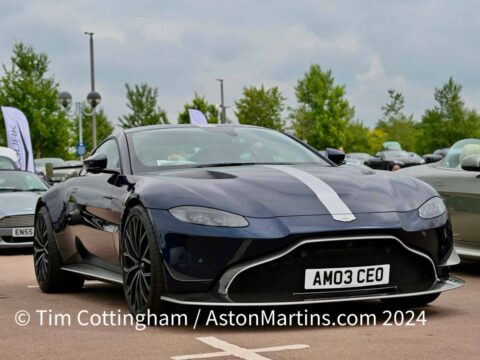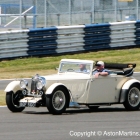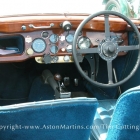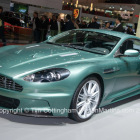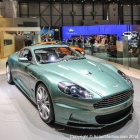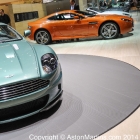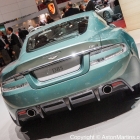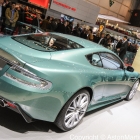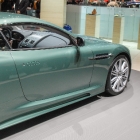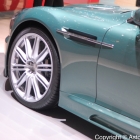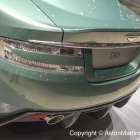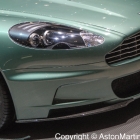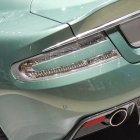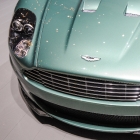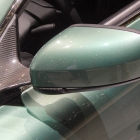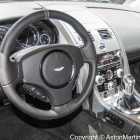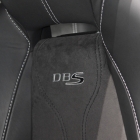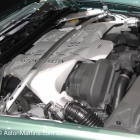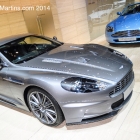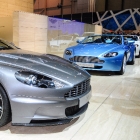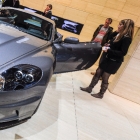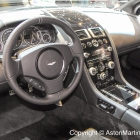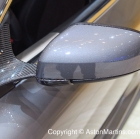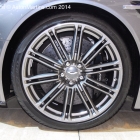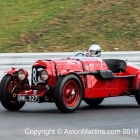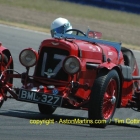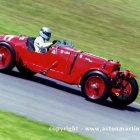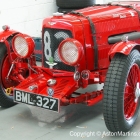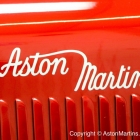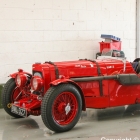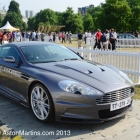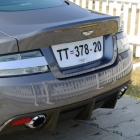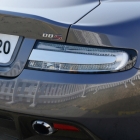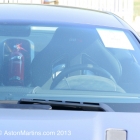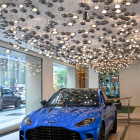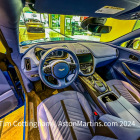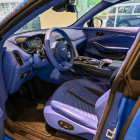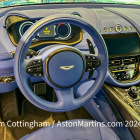From what can be seen, externally, the DBS exactly matched the version seen in Casino Royale; much like a DB9 on which it is closely based but with considerably more menace. The V12 engine was been tuned to produce 510 bhp @ 6500 rpm and 420 lb.ft. of torque at 5750 rpm and was coupled to a close ratio 6-speed gearbox. This allowed a top speed of 191 mph and 0-60 dash in 4.3 seconds. At launch, the DBS was only available with a conventional gear stick and three pedals although Touchtronic 2 became available as an option from late 2008. For the first time on an Aston Martin road car, the DBS had vented carbon ceramic brakes: 398 mm diameter with six pot calipers at the front, 360 mm four pot calipers at the back. Another first for an Aston Martin was carbonfibre composite body panels used for the boot enclosure, boot lid, door opening surrounds, front wings and bonnet, together offering a 30kg saving over the aluminium equivalent. On top of the carbon weave, a patented Surface Veil process was applied a 200 micron layer of epoxy and glass to give the ultra smooth finish expected on an Aston Martin. Three special DBS colours were also introduced for the launch cars and early production cars, Lightning Silver, Casino Royale and Storm Black although these were also made available at additional cost on other cars in the range.
Overall, the weight of the two-seat DBS was 65kg lower than the DB9; by specifying the optional Kevlar and carbon-fibre lightweight seats (not available in North America) provided a further weight saving of 20kg. As a feature, the lightweight seats are desirable to some enthusiast although the lack of backrest adjustment is off-putting to others.
The interior leather was lighter weight semi-aniline and even the standard Phantom Grey carpets were made of a lighter weight fibre. The conventional key was ditched and replaced by a polished sapphire ECU that was inserted into a slot in the starter button. The centre console was changed with a cast metal surround, new graphics and turned aluminium heater knobs.
First view of the production DBS in Europe was at the Frankfurt Motor Show in September 2007. The DBS was also strongly featured at the Geneva Motor Show in 2008 where a DBR9 Green coupe was positioned on the prestigious turntable. Deliveries to customers had begun a month or so before with a UK launch price of £161,147.
Rumours of a watch used to open and close the DBS became reality when fine watch manufacturer, Jaeger-LeCoultre announced the introduction of the 18 carat pink gold AMVOX2 DBS Transponder. Only available to DBS owners through AM dealers, the watch could be used to both lock and unlock the car when the wearer is in close proximity to the car by pressing on the pressure sensitive sapphire crystal watch glass.
Later in the 2009MY run, AML introduced the Touchtronic 2 transmission from the DB9 as a £2000 option, perhaps in response to demand from the US market where true manual cars, or ‘stick’ as they call them are a rarity. Also made optional were lightweight occasional rear seats making the DBS a 2+2. In addition, the DBS was given the bespoke Bang & Olufsen audio equipment as standard featuring rather unusual tweeters that rise out of the top roll on the dash. Another option was the introduction of a new 10 spoke 20 inch lightweight wheel offering a 2kg per wheel reduction in unsprung mass. Pictures of the later 2009MY car above were taken at the Geneva Salon, a 2+2 Touchtronic 2 example. Also introduced later in 2009, the DBS was offered for sale as a Volante with the convertible 2+2 coachwork.
Despite all the weight saving introduced on the DBS, it has to be said that the later cars with rear seats, Touchtronic transmission and B+O audio were significantly heavier than the original series of cars.
For the 2012MY, the DBS received updates in line with those previewed on the Virage, namely, improved Garmin sat-nav and ‘beam blade’ wiper design, incorporating Bosch Aerotwin wiper blades. Touchtronic 2, instead of being a cost option became the standard transmission although in rare cases, manual tranmsission could still be specified as a no-cost option. These last of the line cars are certainly the most desirable especially with the rare manual gearbox and lightweight 2+0 seating configuration.
When production of the DBS finally ended in the Summer of 2012 with the DBS Ultimate editions, an estimated total of 2533 coupes had been built. This number includes all the special editions including the Carbon Black, Carbon Edition, Dragon 88 and UB-2010.
I must point out that AM market this car as a DBS but, for historic classification by the Aston Martin Heritage Trust, this model should be known as the DBS V12 to differentiate it from the 6 cylinder model of the same name introduced in the 1967.

